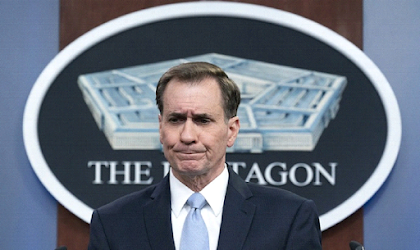April 16, 2022
North Korea launched two short-range projectiles from its eastern city of Hamhung in South Hamkyong Province into the East Sea around 6 p.m.(KST). They flew 110 kilometers and reached an apogee of 25 kilometers and a top speed of Mach 4, according to South Korea's Joint Chiefs of Staff. North Korea has used the "new type guided tactical weapon" to describe its KN-23 or KN-24 short-range ballistic missiles. This solid-fuel close-range ballistic missile launched from a transporter erector launcher (TEL) seen in photos released by the KCNA appeared to be an upgraded variation of KN-23s, North Korea's version of Russia's Iskander-type missiles. (source: Korea Joongang Daily)
 |
Kim Jong Un Observes fire of new-type tactical guided weapon |
May 4, 2022
North Korea launched a ballistic missile eastward from the capital city of Pyongyang at around 12:03 p.m.(KST) before the inauguration of the Yoon Suk-yeol government and the South Korea-US summit. The missile traveled around 470 kilometers at an altitude of 780 km and at a maximum speed of Mach 11, the JCS said. North Korea's state-controlled news outlets were unusually silent about its latest ballistic missile test. (source: Korea Herald)
 |
John Kirby, Press Secretary of U.S. Pentagon, said "We had a nimble posture with respect to North Korea and their future, past and potentially future provocations" |
 |
(source : Korea Joongang Daily) |
May 7, 2022
North Korea fired a submarine-launched ballistic missile (SLBM) on May 7, just four days after conducting a ballistic missile test. The apparent SLBM launch was detected at 2 p.m.(KST) off of the east coast city of Sinpo, according to the JCS. The missile flew 600 kilometers (372 miles) and reached an apogee of 60 kilometers. South Korean military experts have determined that the SLBM seems to have been a mini-SLBM, an improved version of the KN-23, which is a North Korean version of Iskander. (source: Korea Joongang Daily)
 |
SLBM shown on North Korea's military parade |
May 12, 2022
North Korea fired three short-range ballistic missiles from Sunan area in Pyongyang around 6:29 p.m.(KST) toward the East Sea, marking the first major provocation since President Yoon Suk-yeol took office two days ago. They traveled 360 kilometers to a maximum altitude of 90 kilometers at a top speed of Mach 5. (source: Korea Times)
 |
The day of the first COVID-19 outbreak in North Korea on May 12 |
May 25, 2022
North Korea fired three ballistic missiles into the eastern waters off the Korean Peninsula, a day after U.S. President Joe Biden wrapped up his Asia visit. South Korean defense officials believe one was a Hwasong-17, the North's latest intercontinental ballistic missile(ICBM).
Seoul's Joint Chiefs of Staff said it detected the launches as they took place at 6 a.m., 6:37 a.m., and 6:42 a.m.(KST) in the Sunan area of Pyongyang. Military authorities said that the first missile might have been the North's newest ICBM, the Hwasong-17, which they said flew approximately 360 kilometers (224 miles) and reached a top altitude of 540 kilometers.
Officials said the second missile, believed to be a short-range ballistic missile (SRBM), reached an altitude of around 20 kilometers. The last missile, also thought to be an SRBM, traveled some 760 kilometers and reached a peak altitude of 60 kilometers. (source: Korea Joongang Daily)
 |
The North Korean regime's COVID-19 quarantine propaganda drawing |
 |
| (source : Korea Times) |



Comments
Post a Comment